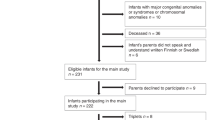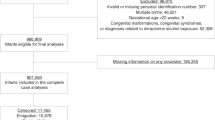Abstract
Introduction
Few studies have examined the relationship between birth plurality and neurocognitive function among children born extremely preterm.
Study design
We compared rates of Z-scores ≤−2 on 18 tests of neurocognitive function and academic achievement at age 10 years in 245 children arising from twin pregnancies, 55 from triplet pregnancies, and 6 from a septuplet pregnancy to that of 568 singletons, all of whom were born before the 28th week of gestation.
Results
In total, 874 children were evaluated at the age of 10 years. After adjusting for confounders, children of multifetal pregnancies performed significantly better on one of six subtests of executive function than their singleton peers. Performance was similar on all other assessments of intelligence, language, academic achievement, processing speed, visual perception, and fine motor skills.
Conclusion
We found no evidence that children born of multifetal pregnancies had worse scores than their singleton peers on assessments of neurocognitive and academic function.
This is a preview of subscription content, access via your institution
Access options
Subscribe to this journal
Receive 12 print issues and online access
$259.00 per year
only $21.58 per issue
Buy this article
- Purchase on Springer Link
- Instant access to full article PDF
Prices may be subject to local taxes which are calculated during checkout


Similar content being viewed by others
References
Deary IJ, Pattie A, Wilson V, Whalley LJ. The cognitive cost of being a twin: two whole-population surveys. Twin Res Hum Genet. 2005;8:376–83.
Ronalds GA, De Stavola BL, Leon DA. The cognitive cost of being a twin: evidence from comparisons within families in the Aberdeen children of the 1950s cohort study. BMJ. 2005;331:1306.
Silventoinen K, Myrskyla M, Tynelius P, Yokoyama Y, Rasmussen F. Social modifications of the multiple birth effect on IQ and body size: a population-based study of young adult males. Paediatr Perinat Ep. 2013;27:380–7.
Voracek M, Haubner T. Twin-singleton differences in intelligence: a meta-analysis. Psychol Rep. 2008;102:951–62.
Calvin C, Fernandes C, Smith P, Visscher PM, Deary IJ. Is there still a cognitive cost of being a twin in the UK? Intelligence. 2009;37:243–8.
Eriksen W, Sundet JM, Tambs K. Twin-singleton differences in intelligence: a register-based birth cohort study of Norwegian males. Twin Res Human Genet. 2012;15:649–55.
Webbink D, Posthuma D, Boomsma DI, de Geus EJC, Visscher PM. Do twins have lower cognitive ability than singletons? Intelligence. 2008;36:539–47.
Deary IJ. Intelligence. Annu Rev Psychol. 2012;63:453–82.
Chambers GM, Hoang VP, Illingworth PJ. Socioeconomic disparities in access to ART treatment and the differential impact of a policy that increased consumer costs. Hum Reprod. 2013;28:3111–7.
Record RG, McKeown T, Edwards JH. An investigation of the difference in measured intelligence between twins and single births. Ann Hum Genet. 1970;34:11–20.
Christensen K, Petersen I, Skytthe A, Herskind AM, McGue M, Bingley P. Comparison of academic performance of twins and singletons in adolescence: follow-up study. BMJ. 2006;333:1095.
Wadhawan R, Oh W, Perritt RL, McDonald SA, Das A, Poole WK, et al. Twin gestation and neurodevelopmental outcome in extremely low birth weight infants. Pediatrics. 2009;123:e220–7.
Bodeau-Livinec F, Zeitlin J, Blondel B, Arnaud C, Fresson J, Burguet A, et al. Do very preterm twins and singletons differ in their neurodevelopment at 5 years of age? Arch Dis Child-Fetal. 2013;98:F480–F7.
Gnanendran L, Bajuk B, Oei J, Lui K, Abdel-Latif ME. Neurodevelopmental outcomes of preterm singletons, twins and higher-order gestations: a population-based cohort study. Arch Dis Child Fetal Neonatal Ed. 2015;100:F106–14.
Yee WH, Hicks M, Chen S, Christianson H, Sauve R. Triplet infants with birthweight < or = 1250 grams: how well do they compare with twin and singleton infants at 36 to 48 months of age? Am J Perinatol. 2008;25:373–80.
McElrath TF, Hecht JL, Dammann O, Boggess K, Onderdonk A, Markenson G, et al. Pregnancy disorders that lead to delivery before the 28th week of gestation: an epidemiologic approach to classification. Am J Epidemiol. 2008;168:980–9.
O'Shea TM, Allred EN, Dammann O, Hirtz D, Kuban KC, Paneth N, et al. The ELGAN study of the brain and related disorders in extremely low gestational age newborns. Early Hum Dev. 2009;85:719–25.
Yudkin PL, Aboualfa M, Eyre JA, Redman CW, Wilkinson AR. New birthweight and head circumference centiles for gestational ages 24 to 42 weeks. Early Hum Dev. 1987;15:45–52.
Leviton A, Paneth N, Reuss ML, Susser M, Allred EN, Dammann O, et al. Maternal infection, fetal inflammatory response, and brain damage in very low birth weight infants. Developmental Epidemiology Network Investigators. Pediatr Res. 1999;46:566–75.
Elliott CD. Differential ability scales. 2nd ed. San Antonio, TX: Pearson; 2007.
E Carrow-Woolfolk. Oral and written language scales: written expression scale manual. Circle Pines, MN: American Guidance Service; 1996.
Wechsler D. Wechsler individual achievement test-III. UK: Pearson Assessment; 2009.
Korkman M, Kemp S. NEPSY: a developmental neuropsychological assessment. New York: The Psychological Corporation; 1998.
Tukey JW. Exploratory data analysis. 6th ed. Reading, MA: Addison-Wesley Co; 1977.
Eras Z, Ozyurt BM, Kanmaz G, Erdeve O, Sakrucu ED, Oguz SS. et al. Neurodevelopmental outcome among multiples and singletons: a regional neonatal intensive care unit's experience in Turkey. Twin Res Hum Genet. 2013;16:614–8.
Feldman R, Eidelman AI. Does a triplet birth pose a special risk for infant development? Assessing cognitive development in relation to intrauterine growth and mother-infant interaction across the first 2 years. Pediatrics. 2005;115:443–52.
Lorenz JM. Neurodevelopmental outcomes of twins. Semin Perinatol. 2012;36:201–12.
Posthuma D, De Geus EJ, Bleichrodt N, Boomsma DI. Twin-singleton differences in intelligence?. Twin Res Hum Genet. 2000;3:83–7.
Wadhawan R, Oh W, Vohr BR, Wrage L, Das A, Bell EF, et al. Neurodevelopmental outcomes of triplets or higher-order extremely low birth weight infants. Pediatrics. 2011;127:e654–60.
Ford RM, Neulinger K, O'Callaghan M, Mohay H, Gray P, Shum D. Executive function in 7-9-year-old children born extremely preterm or with extremely low birth weight: effects of biomedical history, age at assessment, and socioeconomic status. Arch Clin Neuropsychol: Off J Natl Acad Neuropsychol. 2011;26:632–44.
Wong HS, Edwards P. Nature or nurture: a systematic review of the effect of socio-economic status on the developmental and cognitive outcomes of children born preterm. Matern Child Health J. 2013;17:1689–700.
Feldman R, Eidelman AI, Rotenberg N. Parenting stress, infant emotion regulation, maternal sensitivity, and the cognitive development of triplets: a model for parent and child influences in a unique ecology. Child Dev. 2004;75:1774–91.
Bortolus R, Parazzini F, Chatenoud L, Benzi G, Bianchi MM, Marini A. The epidemiology of multiple births. Hum Reprod Update. 1999;5:179–87.
Ooki S. Effect of maternal age and fertility treatment on the increase in multiple births in Japan: vital statistics, 1974–2009. J Epidemiol. 2011;21:507–11.
Dawson AL, Tinker SC, Jamieson DJ, Hobbs CA, Rasmussen SA, Reefhuis J. Epidemiology of twinning in the National Birth Defects Prevention Study, 1997 to 2007. Birth Defects Res A Clin Mol Teratol. 2015;103:85–99.
Feldman R, Eidelman AI. Parent-infant synchrony and the social-emotional development of triplets. Dev Psychol. 2004;40:1133–47.
Manley BJ, Roberts RS, Doyle LW, Schmidt B, Anderson PJ, Barrington KJ, et al. Social variables predict gains in cognitive scores across the preschool years in children with birth weights 500 to 1250 grams. J Pediatr. 2015;166:870–6, e1–2.
Phibbs CS, Baker LC, Caughey AB, Danielsen B, Schmitt SK, Phibbs RH. Level and volume of neonatal intensive care and mortality in very-low-birth-weight infants. N Engl J Med. 2007;356:2165–75.
Ludwig AK, Sutcliffe AG, Diedrich K, Ludwig M. Post-neonatal health and development of children born after assisted reproduction: a systematic review of controlled studies. Eur J Obstet Gynecol Reprod Biol. 2006;127:3–25.
D'Haeseleer E, Vanden Meerschaut F, Bettens K, Luyten A, Gysels H, Thienpont Y, et al. Language development of children born following intracytoplasmic sperm injection (ICSI) combined with assisted oocyte activation (AOA). Int J Lang & Commun Disord/R Coll Speech & Lang Ther. 2014;49:702–9.
Pinborg A, Loft A, Schmidt L, Greisen G, Rasmussen S, Andersen AN. Neurological sequelae in twins born after assisted conception: controlled national cohort study. Brit Med J. 2004;329:311–4B.
Acknowledgements
The authors express their gratitude to the children and their families who participated in this study. They also gratefully acknowledge the contributions of the ELGAN Study Investigators, listed below. The primary author acknowledges the ongoing support of Dr. Leif Nelin and colleagues at Nationwide Children’s Hospital, Columbus, OH.
Funding
This study was supported by funding from The National Institute of Neurological Disorders and Stroke (5U01NS040069-05 and 2R01NS040069-06A2), the National Institute of Child Health and Human Development (5P30HD018655-34), and from the NIH Office of Director (1UGOD023348-01).
The ELGAN Study Investigators
Janice Ware9, Taryn Coster9, Brandi Henson9, Rachel Wilson9, Kirsten McGhee9, Patricia Lee9, Aimee Asgarian9, Anjali Sadhwani9, Ellen Perrin10, Emily Neger10, Kathryn Mattern10, Jenifer Walkowiak10, Susan Barron10, Jean Frazier11, Lauren Venuti11, Beth Powers11, Ann Foley11, Brian Dessureau11, Molly Wood11, Jill Damon-Minow11, Richard Ehrenkranz12, Jennifer Benjamin12, Elaine Romano12, Kathy Tsatsanis12, Katarzyna Chawarska12, Sophy Kim12, Susan Dieterich12, Karen Bearrs12, T. Michael O’Shea13, Nancy Peters13, Patricia Brown13, Emily Ansusinha13, Ellen Waldrep13, Jackie Friedman13, Gail Hounshell13, Debbie Allred13, Stephen C. Engelke14, Nancy Darden-Saad14, Gary Stainback14, Diane Warner15, Janice Wereszczak15, Janice Bernhardt15, Joni McKeeman15, Echo Meyer15, Steve Pastyrnak16, Wendy Burdo-Hartman16, Julie Rathbun16, Sarah Nota16, Teri Crumb16, Madeleine Lenski17, Deborah Weiland17, Megan Lloyd17, Scott Hunter18, Michael Msall18, Rugile Ramoskaite18, Suzanne Wiggins18, Krissy Washington18, Ryan Martin18, Barbara Prendergast18, Megan Scott18, Judith Klarr19, Beth Kring19, Jennifer DeRidder19, Kelly Vogt19
Author information
Authors and Affiliations
Consortia
Corresponding author
Ethics declarations
Conflict of interest
The authors declare that they have no conflict of interest.
Rights and permissions
About this article
Cite this article
Logan, J.W., Allred, E.N., Msall, M.E. et al. Neurocognitive function of 10-year-old multiples born less than 28 weeks of gestational age. J Perinatol 39, 237–247 (2019). https://doi.org/10.1038/s41372-018-0273-x
Received:
Revised:
Accepted:
Published:
Issue Date:
DOI: https://doi.org/10.1038/s41372-018-0273-x
This article is cited by
-
Neurodevelopmental outcome of preterm twins at 5 years of age
Pediatric Research (2020)



